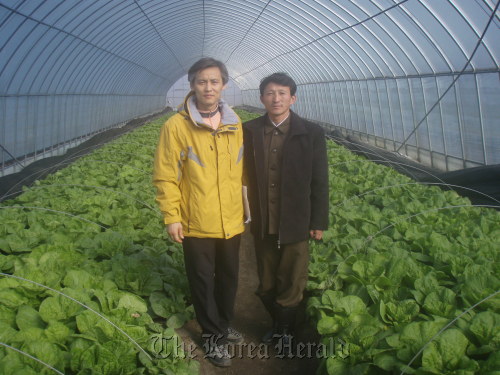Kim Seon-man is more than a pastor working to spread the gospel.
He has also been working as an agricultural advisor to North Korea for more than a decade.
It started in July 2000, when the North’s Geumgangsan Tourist Region, only recently opened to South Korean tourists, had the need for an agricultural expert to teach the locals how to grow vegetables to satisfy the palates of their Southern visitors.
To do this, they needed the help of an actual South Korean. Word spread through tour operators Hyundai Asan, and eventually reached the Seventh Day Adventist Korean Union Conference in Ilsan. The son of a successful farmer, Kim also had experience operating a farm on the Russian island of Sakhalin, northwest of Japan, from 1994-96, not long after Russia had ended its experiment with communism.
This gave the pastor not only the credentials of having managed his own farm, but a desire to form relationships with his Northern neighbors still living in a communist system. Though studying at SDA-operated Sahmyook University in Seoul at the time, Kim was granted permission to take a break from his studies to take part in a most unusual mission.
From the time of his arrival until February 2002, Kim oversaw the construction of a greenhouse and taught the North Korean staff how to grow vegetables there.
He recalled a local populace that was at first hostile, and some of whom were impoverished to the point of barely being able to stand. The area changed noticeably over the next few years, however. For one, South Korean President Kim Dae-jung’s historic summit with North Korean leader Kim Jong-il took place that year, and soon rice aid from the South began shipping in.
The pastor recalled that when he arrived, the locals greeted him by throwing stones at his car. Then, not long after the rice shipments began arriving, they began speaking warmly of both him and South Koreans in general.
His first stint there also coincided with a change in North Korean policy: Rather than having the government take all the crops they could grow and then redistribute them, farmers were given a quota and told that, should they exceed it, they could keep the surplus for themselves.
This was a very new concept for a nation that had, until the collapse of the Iron Curtain, had its agriculture supplied by its ideological allies in the Soviet Union.
“This was a big motivation,” Kim said. “They were very lazy (before the change), but they became active.”
By the time he returned to the South, the area had also added a pig farm to supply the greenhouse with fertilizer. Then, two other farms in North Korea ― another in Gaeseong, and another near Geumgang ― were set up with Kim’s farm as the model.
After returning to the South to work in the ministry, Kim would make trips back to the farm about once a month to see how operations were progressing.
A few years later, a group of church members came together, calling themselves the Council for Peace Cooperation, to accompany Kim on his trips there. Together, the group visited the Geumgang area four times starting in 2006 to complete a variety of projects, including digging a well and building an embankment that would shield the greenhouse against flooding from the sea.
One of them was Jooch Nam, a Korean-American SDA church member working in Seoul. Though he went just once, Nam said that he immediately found stereotypes about North Koreans that did not match reality. For one thing, black market activity is so rampant that many of them had been exposed to South Korean products, including entertainment.
“At least half of them know exactly what’s happening (in the outside world),” he said, “that they are being deceived.”
But the group’s work in the North came to an end in the summer of 2008, when South Korean tourist Park Wang-ja was shot dead at the Geumgang resort. Since then South Korean tourists have not been able to go there, and the CPC has not been back. While Kim was able to return to observe work on the farm occasionally, his last trip was in November, only weeks before the attack on Yeonpyeong.
Though its political system and relations with the outside world are major causes of its misery, at least some of the North’s difficulty in feeding its people is inherent: While the Northern half of the peninsula is the richer of the two in mineral resources, it lacks the farmland found in the South.
This is one reason why Kim believes the food aid to the North should be resumed, not just from the South, but nations around the world.
“North Korea should be helped by other people,” he said. “In other countries, if they work hard they will not starve. If North Koreans work hard, they will still starve (without help).”
Across the DMZ, Kim can remember a horde of North Koreans hungry not just for food, but for unification with the South. This was a wish they would frequently express, and even with tensions rising over the sinking of the Cheonan and shelling of Yeonpyeong, he believes it’s still what they want.
Nam also remembers this: “They want (unification) more than we do. They would all say, ‘Are you guys ready? We’re ready.’ And these were military.”
Meanwhile, the CPC remains idle, hoping for a breakthrough in intra-Korean ties so that it may resume its work.
“This group, they are ready even now,” Kim said. “If the relationship between the North and South gets better, why not?”
By Rob York (
rjamesyork@heraldcorp.com)








![[Today’s K-pop] Blackpink’s Jennie, Lisa invited to Coachella as solo acts](http://res.heraldm.com/phpwas/restmb_idxmake.php?idx=644&simg=/content/image/2024/11/21/20241121050099_0.jpg)